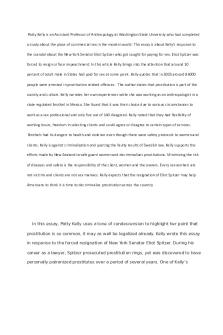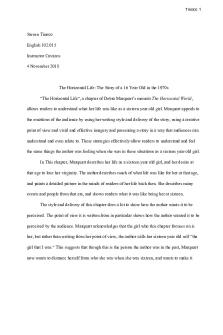Bowling Dana Rhetorical Analysis PDF

| Title | Bowling Dana Rhetorical Analysis |
|---|---|
| Author | Dana Cox-Bowling |
| Course | English Composition I |
| Institution | Sinclair Community College |
| Pages | 4 |
| File Size | 71.5 KB |
| File Type | |
| Total Downloads | 17 |
| Total Views | 166 |
Summary
Analysis of the speech "A Whisper of AIDS" by Mary Fischer...
Description
Bowling 1 Dana Bowling Jamey Dunham, M.F.A. ENG 1101.531 10/22/20 Mary Fisher, A Whisper of AIDS: A Rhetorical Analysis “A Whisper of AIDS” is ranked as one of the top 100 greatest American speeches of the 20th Century. Delivered on August 19, 1992 at the Republican National Convention, Mary Fisher, mother of two young children, television producer, and the first woman “advanceman” for Gerald Ford, shares her personal story of having HIV, plea to “lift the shroud of silence,” take a stand, bring awareness to the epidemic of HIV and AIDS, and remind everyone that no one is safe from the disease. It is also a message of comfort and hope to those who suffer from the epidemic. Mary Fisher employs the rhetorical appeals of ethos, pathos, and logos effectively, particularly with her use of personal story and experience with the president, which helps greatly establish credibility, and produces a speech which is memorable and emotionally powerful. Fisher’s speech is infused with ethos appeals. From the very beginning, she mentions being at platform hearings in Salt Lake City, asking the Republican Party to “lift the shroud of silence which has been draped over the issue of HIV and AIDS.” She mentions wanting attention and not applause, which gives a feeling of how seriously she takes this matter. Adding to credibility, she mentions President Bush standing behind her and showing not only support, but affection as well. Ethos appeals can be felt when sharing her own story of HIV and the dedication she pledges not only to her children, but to the world itself, to be a messenger and fight until her last breath. Her intended tone seems to be focused on morality and even with everything she went through with her marriage, eventual positive diagnosis, and raising two sons who may not have a full life with her, she still insists that she is not a victim; in fact, she states she is blessed compared to many, and wants to reiterate multiple times that she is a messenger
Bowling 2 who acts with courage. Her morality is clearly stated to the audience appealing to ethos and gives little room for questioning her values and motives. Along with the strong ethos appeals, Fisher makes appeals to pathos throughout the entire speech. Her goal to help the audience feel the human factor in suffering is met with her repetition of asking the question, “Are you human?” while mentioning that HIV only cares about that one fact. When the audience can think on the human level, Fisher’s approach works when people who have HIV and AIDS do not deserve to be treated any differently. Judging someone feels harder when the human factor is fresh in the mind and people put themselves in those shoes. Pathos appeals to provoke sympathy are widely used throughout the entire speech. Such words and phrases that bring about those feelings could include “lonely,” “rejection,” “grieving,” “frightened,” “suffered the ravages of AIDS,” and “weep silently.” Another feeling Fisher reinforces with her word choice is urgency. She mixes logos and pathos appeals with statistics about the death and infection rates, while her language clearly demonstrates the need for change. She mentions that it is not a distant threat, but a “present danger.” The language has a strong tone to it, blaming deaths on ignorance, prejudice, and silence. This could provoke multiple emotions from an audience such as guilt, anger, or disbelief, but her goal was to have strong language to elicit the attention of the audience. This is also repeated with her mention of “littering its pathway with the bodies of the young – young men, young women, young parents, and young children.” This produces vivid imagery and again, grabs the attention of the audience. Additionally, her last portion of the speech refers to her plea of setting aside prejudice and politics to make room for compassion and sound policy, along with her pledge to her children to never give in. This language is an appeal to pathos, giving a strength to her spirit that
Bowling 3 could be admired enough to set her as a role model for audience members, particularly mothers or parents in general. Through her use of effective rhetoric appeals, personal and professional credibility built throughout the speech, thought provoking imagery and facts, and powerful delivery, it is clear from the analysis that the speech was able to produce the desired effect of awareness, humanity, urgency, and compassion that Mary Fisher had intended for the nation that night. As mentioned, ranking as one of the top 100 greatest American speeches of the 20th century, there is no question that Mary made an impression on her audience.
Bowling 4 Works Cited “American Rhetoric Top 100 Speeches.” Translated by Kristin Simar and Michael E. Eidenmuller, American Rhetoric: Mary Fisher -- 1992 Republican National Convention Address ("A Whisper of Aids"), American Rhetoric, 2019, www.americanrhetoric.com/speeches/maryfisher1992rnc.html.
Fisher Productions, Inc, Mary. Mary Fisher: A Celebrated Artist, Author and Speaker, 2016, www.maryfisher.com/....
Similar Free PDFs

Bowling Dana Rhetorical Analysis
- 4 Pages

Rhetorical Analysis
- 5 Pages

Rhetorical analysis
- 2 Pages

Puppy Rhetorical Analysis
- 4 Pages

Rhetorical analysis -1
- 4 Pages

Rhetorical Analysis Essay
- 5 Pages

Textual Rhetorical Analysis
- 3 Pages

Rhetorical Analysis Final
- 5 Pages

Rhetorical Analysis Prompt
- 2 Pages

Final Rhetorical Analysis Essay
- 2 Pages

Rhetorical analysis pt1
- 2 Pages

Rhetorical Analysis - enc2135
- 6 Pages

Rhetorical Analysis Essay
- 4 Pages
Popular Institutions
- Tinajero National High School - Annex
- Politeknik Caltex Riau
- Yokohama City University
- SGT University
- University of Al-Qadisiyah
- Divine Word College of Vigan
- Techniek College Rotterdam
- Universidade de Santiago
- Universiti Teknologi MARA Cawangan Johor Kampus Pasir Gudang
- Poltekkes Kemenkes Yogyakarta
- Baguio City National High School
- Colegio san marcos
- preparatoria uno
- Centro de Bachillerato Tecnológico Industrial y de Servicios No. 107
- Dalian Maritime University
- Quang Trung Secondary School
- Colegio Tecnológico en Informática
- Corporación Regional de Educación Superior
- Grupo CEDVA
- Dar Al Uloom University
- Centro de Estudios Preuniversitarios de la Universidad Nacional de Ingeniería
- 上智大学
- Aakash International School, Nuna Majara
- San Felipe Neri Catholic School
- Kang Chiao International School - New Taipei City
- Misamis Occidental National High School
- Institución Educativa Escuela Normal Juan Ladrilleros
- Kolehiyo ng Pantukan
- Batanes State College
- Instituto Continental
- Sekolah Menengah Kejuruan Kesehatan Kaltara (Tarakan)
- Colegio de La Inmaculada Concepcion - Cebu


